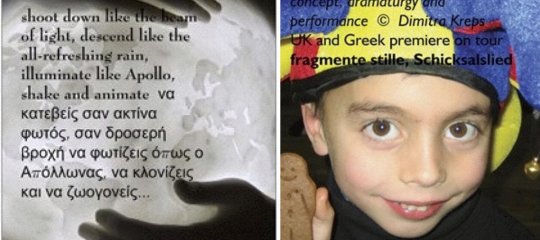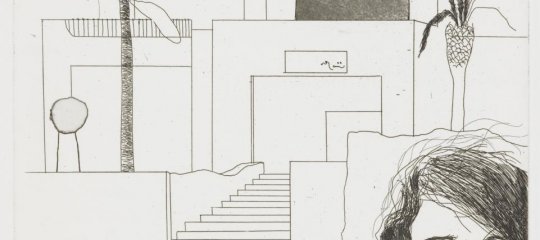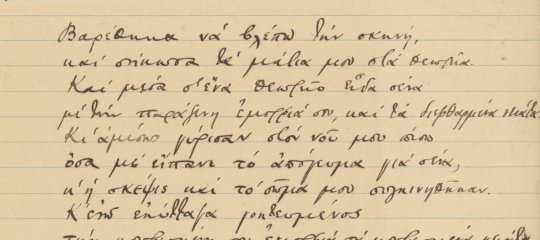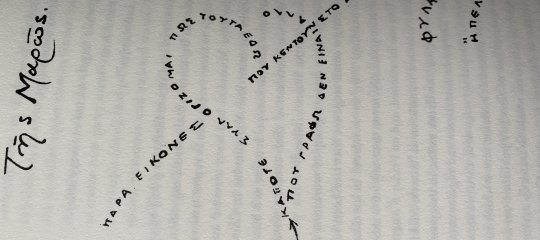Παιχνίδι με ένα τραγούδι του Πορτοκάλογλου - Αρετή Πότσιου
Αρετή Πότσιου
1. Ακούμε το τραγούδι μία ή δύο φορές (ανάλογα με τις ανάγκες της τάξης), χωρίς όμως να έχουμε δώσει ακόμη στα παιδιά τις φωτοτυπίες και με την επισήμανση να δοθεί κάποια προσοχή στους χρόνους των ρημάτων. Αυτή η πρώτη φάση μπορεί και να παραληφθεί.
2. Δίνουμε στα παιδιά φωτοτυπία με το τραγούδι, με κενά στη θέση των ρημάτων. Τα κενά πρέπει να συμπληρωθούν με τα ρήματα που δίνονται παρακάτω, στον κατάλληλο τύπο και με τρόπο,
ώστε οι στίχοι να έχουν νόημα, υπηρετώντας και την αίσθηση του μέτρου, ει δυνατόν. Η επιλογή της κατάλληλης λέξης γίνεται χωρίς να ακούμε το τραγούδι. Με αυτόν τον τρόπο δυσκολεύουμε λίγο την άσκηση
3. Ακούμε το τραγούδι για τελευταία φορά και διορθώνουμε, διασκεδάζοντας με τα αλλόκοτα αποτελέσματα της κάλυψης των κενών που είχε προηγηθεί.
4. Δίνουμε ηλεκτρονικές σελίδες, όπου μπορούν να βρουν αυτό και άλλα τραγούδια του Ν.Π, π.χ. τη θάλασσά του τη σκοτεινή, που έχει μεγάλο σουξέ στους φοιτητές μας συνήθως, αλλά που θα την απολαύσουμε εν ευθέτω χρόνω, κατά την προβολή της ταινίας Μπραζιλέρο.
ΤΡΕΧΩ, ΤΡΕΧΩ, ΤΡΕΧΩ
Ποιος να είναι αυτός που ______________ ,
αυτός που _________ στην αυλή σου και __________
αυτός που μπαίνει και ____________
και σου _________ όλα τα χρέη τα παλιά…
Ποιος να είναι και ποιος τον ___________
ό,τι έχτισες στην άμμο να γκρεμίσει;
Δεν τον __________ , δεν τον _____________ , (β΄ ενικό)
μα _________ πάντα μ’ ένα φόβο στην καρδιά … (β΄ ενικό)
Κι όλο __________ , __________ , __________ ,
κι όλο __________ να ________ ,
με ____________ κι όλο τρέχω (γ΄ πληθυντ)
κι εγώ τους άλλους ____________ .
Ποιος να είναι αυτός που ___________,
αυτός ο άγνωστος που __________ εδώ κοντά σου;
Τι σου ζητούσε, τι ____________ ,
τι ________________ τόσα χρόνια να σου _____ ; (γ΄ ενικό)
Ποιος να είναι αυτός που ___________ ,
και τώρα ___________ ποιος είσαι, πού ______________ . (β΄ ενικό)
Ναι, πού πηγαίνεις κι από πού ____________ (β΄ ενικό)
και τι ’ναι αυτό που ______________ μια ζωή… (β΄ ενικό)
Συμπληρώστε τα ρήματα:
γκρεμίζω
γνωρίζω
έρχομαι (2 φορές)
ζητάω (2)
ζω (2)
κοιτάω
κυνηγώ (3)
λέω (πω)
μπαίνω (2)
ξεχνάω (ξέχασα)
πηγαίνω (2)
προσπαθώ (προσπαθούσα)
περιμένω (2)
στέλνω (έστειλα)
σώζομαι (σωθώ)
τρέχω (5)
φεύγω
χαιρετάω
χάνω
χτίζω
Δείτε εδώ αρκετά τραγούδια του, μερικά με μεταφράσεις
ΤΡΕΧΩ, ΤΡΕΧΩ, ΤΡΕΧΩ
Ποιος να είναι αυτός που έρχεται
αυτός που μπαίνει στην αυλή σου και κοιτάει.
Αυτός που μπαίνει και χαιρετάει
Και σου ζητάει όλα τα χρέη τα παλιά…
Ποιος να είναι και ποιος τον έστειλε
ό,τι έχτισες στην άμμο να γκρεμίσει.
Δεν τον γνωρίζεις, δεν τον περίμενες
Μα ζούσες πάντα μ’ ένα φόβο στην καρδιά…
Κι όλο τρέχω, τρέχω, τρέχω
Κι όλο τρέχω να σωθώ.
Με κυνηγάνε κι όλο τρέχω
Κι εγώ τους άλλους κυνηγώ.
Ποιος να είναι αυτός που έφυγε.
Αυτός ο άγνωστος που ζούσε εδώ κοντά σου.
Τι σου ζητούσε, τι περίμενε,
τι προσπαθούσε τόσα χρόνια να σου πει.
Ποιος να είναι αυτός που έχασες
και τώρα ξέχασες ποιος είσαι, πού πηγαίνεις.
Ναι, πού πηγαίνεις κι από πού έρχεσαι
και τι ’ναι αυτό που κυνηγούσες μια ζωή…
(Νίκος Πορτοκάλογλου, από την ταινία του Σωτ. Γκορίτσα Μπραζιλέρο)










